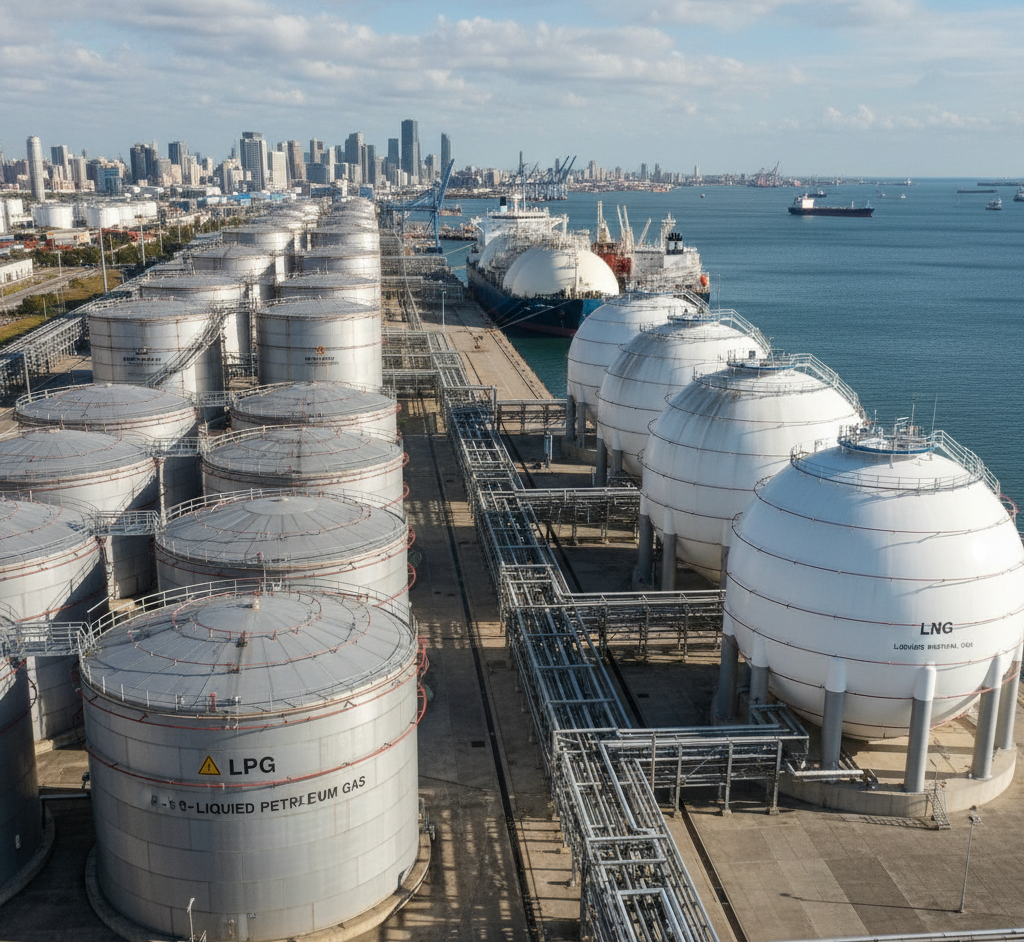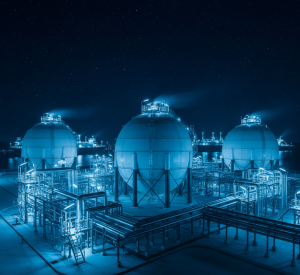Difference Between LPG and LNG – Key Properties, Uses and Export Routes

Introduction
In the modern energy landscape, LPG (Liquefied Petroleum Gas) and LNG (Liquefied Natural Gas) are two crucial fuels that power homes, industries, and economies across the world. Despite their similar acronyms, these two energy sources differ fundamentally in composition, storage, transport, and usage.
Understanding the difference between LPG and LNG is essential for energy professionals, traders, policymakers, and even consumers who use these fuels in their daily lives.
In this article, we’ll take a clear look at how LPG and LNG are produced, what makes them different, and how each plays a unique role in the global energy trade and transition toward cleaner fuels.

“LPG and LNG are both vital fuels powering modern energy systems worldwide.”
What Is LPG?
Definition and Composition
Liquefied Petroleum Gas (LPG) is primarily composed of propane (C₃H₈) and butane (C₄H₁₀) — hydrocarbons derived as by-products during crude oil refining or natural gas processing.
At room temperature and moderate pressure (8–12 bar), these gases become liquid, which makes them easy to store and transport.
Production and Storage
LPG is obtained in two main ways:
- As a by-product of refining crude oil into gasoline and diesel.
- During natural gas extraction and separation, where heavier hydrocarbons are isolated.
It is stored in pressurized steel cylinders, bulk tanks, or large spherical storage vessels.
Key Features of LPG
- Stored at moderate pressure (8–12 bar)
- High energy density, making it efficient for small-scale use
- Easily transportable in cylinders or road tankers
- Highly flammable, requiring careful handling
- Commonly used for cooking, heating, and small industrial processes
What Is LNG?
Definition and Composition
Liquefied Natural Gas (LNG) is natural gas (mostly methane, CH₄) that has been cooled to around -162°C, transforming it into a clear, non-corrosive liquid.
Unlike LPG, it’s not stored under pressure but rather at cryogenic temperatures to remain in liquid form.
Production and Storage
To produce LNG, natural gas is purified to remove water, CO₂, and impurities, and then cooled in a liquefaction plant. The resulting liquid occupies only 1/600th of the volume of its gaseous state, making it ideal for long-distance transport via specialized LNG carriers.

“LNG – Natural gas cooled to -162°C and stored in cryogenic tanks for transport.”
Key Features of LNG
- Composed mainly of methane (CH₄)
- Stored at cryogenic temperatures (-162°C)
- Low pressure, high safety design for storage tanks
- Cleaner combustion compared to LPG and diesel
- Primarily used for power generation, large industries, and transport fuel
Main Differences Between LPG and LNG
In essence, LPG is more compact and portable, while LNG is optimized for massive energy transport and large-scale industrial use. Their storage and transportation infrastructures are also entirely different — LPG requires pressurized systems, whereas LNG needs cryogenic technology.

“Key technical differences between LPG and LNG in composition, storage, and applications.”
Applications and Market Trends
LPG Applications
- Residential: Cooking, space heating, hot water systems
- Industrial: Metal cutting, drying, ceramics, small power units
- Automotive: LPG-powered vehicles (autogas)
- Agriculture: Crop drying and pest control
LPG’s portability and high energy density make it a favorite in developing regions where natural gas pipelines are limited.
LNG Applications
- Power Generation: Major energy source for electricity in Asia and Europe
- Transportation: Used in LNG-fueled ships, buses, and heavy trucks
- Industrial Fuel: For large-scale heating, chemicals, and manufacturing
- Export and Storage: Shipped globally via LNG tankers and stored in regasification terminals
The global LNG market is expanding rapidly as nations seek to reduce carbon emissions and move away from coal-based power generation.

“LPG and LNG power everything from homes and vehicles to global industries.”
Export Routes and Global Trade
LPG Export Routes
Major LPG exporters include Saudi Arabia, Qatar, the United States, and the United Arab Emirates. Typical export routes pass through the Persian Gulf, the Suez Canal, and the Indian Ocean, connecting key markets in Asia, Africa, and Latin America.
Growing demand in India, China, and Southeast Asia continues to drive LPG trade, particularly for domestic and industrial use.
LNG Export Routes
Top LNG exporters are Qatar, Australia, the United States, and Russia. Exports are mainly shipped via large cryogenic tankers to Asia (China, Japan, South Korea, India) and Europe (Spain, France, the UK, and Italy).
The LNG market often operates under long-term contracts (15–20 years) to ensure supply stability. Recently, spot market trading has also grown, increasing price flexibility.
Environmental Considerations
LPG and the Environment
LPG burns more cleanly than coal or diesel but still emits more CO₂ per unit of energy than LNG. It is, however, an excellent transitional fuel in rural and developing areas where access to electricity or pipelines is limited.
LNG and the Environment
LNG is regarded as one of the cleanest fossil fuels, producing up to 30% less CO₂ and almost no sulfur oxides or particulate matter compared to oil-based fuels. It is becoming a cornerstone of the global low-carbon energy transition, particularly for countries balancing environmental goals with energy security.
Economic and Strategic Significance
Both LPG and LNG have strong strategic importance in global energy security. LPG supports decentralized energy systems and small consumers. LNG facilitates international trade on a massive scale and stabilizes global gas prices. Emerging technologies such as bio-LPG and synthetic LNG are also being developed, showing how both fuels are evolving toward sustainable and carbon-neutral futures.

“Both LPG and LNG play strategic roles in global energy security and trade.”
Conclusion
While LPG and LNG share the ‘liquefied gas’ label, they serve distinct functions in the world’s energy ecosystem. LPG is versatile, portable, and ideal for domestic and small-scale industrial use. LNG is the backbone of global natural gas trade, powering large industries and electricity generation. By understanding these differences, energy planners, investors, and consumers can make smarter decisions as the world moves toward cleaner and more efficient energy solutions.
